Northern and arctic societies. Рубрика в журнале - Arctic and North
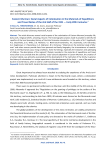
Статья научная
The article discusses several social aspects of the colonization of Eastern Murman (everyday life, daily work, religious beliefs, schooling, leisure). The historiographic analysis made it possible to identify the specifics of the local (everyday) history of the Kola Peninsula colonization. In the works of A.P. Engelhardt, A.G. Slezskinsky, S.Yu. Witte, S.O. Makarov, V.I. Nemirovich-Danchenko, K.K. Sluchevsky, D.N. Ostrovsky, A.K. Engelmeyer, V.I. Manotskov, A.K. Sidensner, N.V. Romanov, “Materials on the statistical study of Murman” and other sources provide facts from personal and family biography, the circumstances of resettlement to the Murmansk coast, living conditions, home furnishings, especially the education and upbringing of children. The descriptions of the migrants’ lifestyle recorded in the materials of expeditions and travel notes allow us to conclude that the colonists’ socio-cultural adaptation in Eastern Murman, the creation of a human habitat, was primarily associated with the development of the institution of the family. In general, the history of colonization is a unique experience in the development of the Arctic - one of the most productive in world history, which is vital for understanding the Russian North’s geography.
Бесплатно
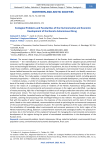
Статья научная
The current stage of economic development of the Russian Arctic combines two contradicting tendencies — the intensification of economic development in line with the adopted special preferential measures and the aggravation of technical and technological contradictions under the tightening of sanctions and technological blockade, increasing wear of equipment, the loss of markets for extracted products. Under these conditions, anthropogenic and, particularly, technogenic environmental threats to nature and human habitat become the most important risk factor. The purpose of the work is to identify current ecological threats, problems and features of the environmental and economic development of the Nenets Autonomous Okrug. The study applies a comprehensive economic and sociological toolkit, including general theoretical approaches — dialectical, spatial economics and sustainable development, and private methods — statistical analysis, a number of sociological methods of collecting and processing data. The information basis of the study is the data of official authorities, statistics, the work of domestic and foreign scientists, as well as the results of a sociological survey of residents of the Nenets Autonomous Okrug (May 2022; n=539). Key features of environmental and economic processes in the region were identified. Low degree of waste processing, high risks of technogenic accidents at oil and gas production enterprises and transport infrastructure remain. The main environmental threats perceived by the population include oil and gas production facilities, household waste and illegal dumps. In a number of territories, threats from defense activities, catching and processing of fish and illegal fishing are also relevant. The population is least satisfied with the quality of water resources, the cleanness of the environment and the state of forests and parks. Based on the results obtained, recommendations aimed at optimizing the environmental component of the social well-being of the population are given. The scientific significance of the study is determined by the actualization of knowledge about environmental and economic processes in the Arctic region of the Nenets Autonomous Okrug, based on a comprehensive economic and sociological toolkit. The practical importance lies in the formation of the analytical framework for managing the environmental and economic development of the regions during the period of exacerbated contradictions in the development of the Russian Arctic.
Бесплатно
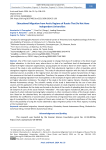
Educational Migration from Arctic Regions of Russia That Do Not Have Independent Universities
Статья научная
One of the main reasons for young people to change their place of residence is the desire to get higher education. In the Arctic zone, where there is a lack of or insufficient level of development of the network of higher education organizations, young people are forced to leave for other regions. The relevance of the study is also conditioned by the fact that educational migration is often irrevocable, which strengthens negative migration processes. The study of educational migration with the help of traditional statistical sources is possible at the regional level, but does not reveal the spatial characteristics of migration processes at the level of municipalities. Therefore, the purpose of this study is to approbate the methodology of studying migration from municipalities on the example of regions where there are no independent higher education institutions. The object of the study is the Arctic regions: Nenets, Chukotka, Yamalo-Nemets Autonomous okrugs. The scientific novelty of the study is determined by the use of new data sources and the application of the method of big data analysis to study migration processes at the municipal level. The database for the study was formed on the basis of the results of uploading data from the digital footprint of users of the social network “VKontakte”. The study regions included 15,186 users, the vast majority of whom indicated receiving higher education in other constituent entities of the Russian Federation. Based on the obtained data, the trajectories of educational migration at the municipal level were identified, the coefficients of concentration and uniformity of migration flow were calculated, and a typology of municipalities in the Arctic regions of Russia was carried out. The practical significance of the study lies in the possibility of using the results obtained to adjust migration policy in the Arctic regions, including at the municipal level.
Бесплатно
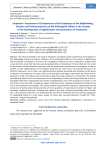
Статья научная
The article is devoted to the study of employers’ perceptions of the competences of employees in the shipbuilding, fishing and forestry industries of the Arkhangelsk Oblast in the context of digitalization and automation of production. As part of the sociological research, the team conducted a questionnaire survey and semi-structured interviews among representatives of enterprises in these industries. The results of the research allowed drawing conclusions that the professional competencies of employees, as well as abilities to work independently, in non-standard situations and under stress are currently the most in demand for employers. There is also a very high demand for qualities associated with discipline and the desire to develop in the profession. In terms of the size of enterprises, the higher requirement for almost all competences in small and medium-sized enterprises compared to large employers is noteworthy. The authors conclude that about half of the enterprises in the shipbuilding, forestry and fishing industries of the Arkhangelsk Oblast have implemented automation and digitalization into all key production processes. In the near future, more than 50% of employers expect a high demand for employee competencies related to the use of new production technologies. The survey revealed a gap between employers’ expectations and the actual level of professional training and skills of recent graduates of educational institutions of higher and secondary vocational education, including with regard to the most in-demand knowledge, skills and abilities. In the context of industries, it is noteworthy that the level of satisfaction with the training of graduates of shipbuilding industry is much lower, except for those who received education through the “Plant-University” system (Severodvinsk).
Бесплатно
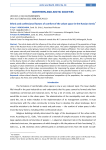
Ethnic and confessional factors of comfort of the urban space in the Russian Arctic
Статья научная
The article deals with the influence of the ethnic and religious structure of the population of large cities of the Russian Arctic on the comfort of the urban space. The authors highlight the basic requirements for the urban area by social groups, based on their ethnic and religious affiliation. The main urban objects and spaces naturally and historically created for the needs of ethnic and religious groups are determined. The study used methods of social mapping, observation, analysis of statistical data. On the example of large cities in the regions of the Russian Arctic, the authors show the unsystematic nature of meeting ethnic and religious needs in the creation of comfortable urban space. According to the authors, this is primarily due to the diverse history of urban settlements in the Arctic zone, as well as the functional purpose of settlements, which differ in number and composition of residents. Based on this differentiation, the corresponding types of urban settlements are distinguished. Based on the relatively successful example of the policy of the capital region, the article makes recommendations for improving the proper administration of the urban municipalities of the Russian Arctic. Attention is drawn to the possible features of such a policy, considering the specifics of the Arctic cities and migration processes taking place in the region.
Бесплатно
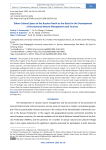
Статья научная
The purpose of the study is to draw attention to the issue of developing domestic tourism in the North-West region of the Russian Federation and preserving unique historical and cultural heritage sites in the Russian North. Generalization of global experience shows that recreational nature management, domestic tourism, and international Arctic cruise tourism in the northern countries are currently becoming increasingly widespread and can have a significant economic impact. As a result of the field historical and geographical studies conducted by the authors on the territory of the North-Western Federal District of the Russian Federation and analysis of literature and exhibitions of cultural heritage sites presented in regional Arctic museums, the rich historical and cultural tourism potential of the region has been revealed. Special attention is paid to the reconstruction of routes along ancient waterways. These routes contain the most valuable natural and cultural heritage sites that are of interest to tourism and require protection and promotion. The possibilities of using the exhibits of local history museums in the Arctic region for the preservation of heritage sites and the development of local history, recreation, and tourism are considered. It is shown that the modern development of tourism and recreational nature management should contribute to the sustainable development of the northern regions of the country.
Бесплатно
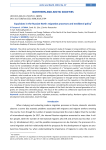
Expulsions in the Russian North: migration processes and neoliberal policy
Статья научная
The article summarizes the results of a long-term study of changes in living conditions of the population in the North during the formation of trade capitalism and the spread of neoliberal policy. Expulsion is considered as an institutionally organized way of exception in the form of state policy, actively supporting social polarization, contributing to consumer way of natural resource development and extensive use of before-built infrastructure, and accompanied by the isolation of the experience, disregard of the interests and violation of the rights of residents. The article proves that Soviet policy, interested in attracting labor to develop the Russian North and used a distribution system of goods for these purposes, did not contribute much to the consolidation of labor migrants in the northern territories as it initiated their return to the homeland at the end of their labor biography. The position of a "temporary worker" was formed by the proposed privileges, which served a compensation for work in adverse climatic conditions but did not contribute to the prospects for the development of the northern territories. At the same time, the interests of residents, who turned out to be cut off from prestigious jobs and found themselves in worse living conditions, were regularly ignored, and their rights were unrecognized. If, through vertical mobility and integration into the Soviet distribution system, it was possible to smooth out the inequities in the distribution of benefits, it became more difficult to hide this with the country's transition to the market and the beginning of a new phase of natural resource extraction. Moreover, considering the exclusion processes have become more widespread. Now not only the indigenous peoples of the North but also the second generation of migrants are among the vulnerable groups. The focus of the conflict has shifted and expressed itself in the relations between the residents of the Center and the regions.
Бесплатно
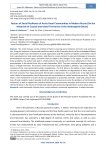
Статья научная
The article focuses on the problem of factors ensuring social resilience of Arctic rural communities. Using the materials of island and coastal territories of the Primorskiy district of the Arkhangelsk Oblast, the author studies how the features of social organization and life activities of specific communities ensure their reproduction as local social systems, help them to remain resilient to external challenges of economic, environmental and other types, and allow them to adapt to the changes in the region. In order to solve these problems, the author took part in a field study on the territory of 14 rural settlements in three rural municipalities in the period from July to early September 2022. The main method of obtaining empirical data is in-depth interview. The analysis of the interviews made it possible to identify a set of key factors of resilience of the rural communities under consideration. The first factor is the ability of local residents to reorient to subsistence farming and traditional crafts in the conditions of degradation of those sectors of the local economy that imply permanent formal labor employment. The second factor is the high level of social capital of communities, which determines the normalization of mutual assistance practices. The third factor is the involvement of a part of the local population in grassroots activities: social and cultural initiatives of local residents make it possible to attract external resources to solve the problems of territorial development, as well as support the collective identity of rural community members and increase its cohesion. The fourth factor is the return of retired local natives who previously migrated from rural to urban areas.
Бесплатно
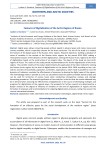
Features of Digitalization of the Arctic Regions of Russia
Статья научная
Digital space allows connecting people without regard to physical space and makes many social services available, which is especially relevant for the Arctic territories. The aim of the study is to analyze the features of the digital space of the Russian Arctic regions. Research objectives: building a database of series of variables in the context of the Russian Arctic regions for the period 2014-2020, making a retrospective analysis of the dynamics of their digitalization, ranking the Russian Arctic regions by the level of digitalization based on the construction of an integral index. The objects of the study are nine Arctic regions of Russia. The results of the study provide recommendations for further digitalization of the Arctic regions. The scientific novelty of the study is determined by the application of the index method for ranking the Russian Arctic regions by the level of digitalization for the period 2014-2020 according to four sub-indices: activities of households, population, authorities, organizations, which made it possible to trace the dynamics of indicators, evaluate the effectiveness of measures to develop the digital space of the regions. The methodology makes it possible to carry out calculations based on publicly available statistical data and can be used for territories of various levels when conducting retrospective analysis and strategic forecasting procedures. The practical significance of the study lies in the fact that the results obtained may be in demand when assessing the effectiveness of digitalization in the course of developing strategies and programs for digitalization of the regional space. The prospects for further research are determined by a deeper analysis of the degree of influence of variables on the level of digitalization of regions and the formation of proposals and recommendations for adapting digitalization processes, taking into account the current international situation.
Бесплатно
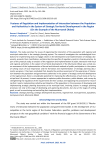
Статья научная
The study examines the issues of organizing the interaction of the population with regional and municipal authorities in the strategic planning system. The research investigates the methodological foundations for implementing tools to engage citizens in the development and implementation of strategic documents, presents their classification, and describes the specifics of regulatory control in Russian practice. As part of the practical study, an analysis of the regulation and implementation of public interaction with local and regional authorities in the system of territorial development of the Murmansk Oblast was carried out, an assessment of the implementation of formal and informal methods of public participation in the system of solving issues of local importance and the formation and implementation of strategic planning documents was given. It has been concluded that, despite the positive assessment of the experience of interaction between the population and government authorities in the system of strategic territorial development at the regional level, there is considerable potential for improving the effectiveness of such tools at the municipal level. At present, it seems appropriate to optimize public discussions, public debates, and surveys by strengthening the regulation of the requirements for their conduct and regulating the procedure for recording their results, implementing collective participation of the population in the processes of developing and implementing strategic planning documents at the municipal level, involving citizens in strategic planning processes not only at the stage of developing and approving documents, but also at the stages of setting goals, as well as monitoring and controlling their implementation.
Бесплатно
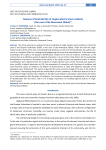
Features of local identity of single-industry town residents (the case of the Murmansk oblast)
Статья научная
The article presents an analysis of the local identity of single-industry town residents in the Arctic zone of the Russian Federation (AZRF) in the case of the Murmansk Oblast, which has half the single-industry towns of the Arctic zone. Considering local identity as a part of territorial identity, the authors present it as a symbolic space for creating and strengthening the sense of territorial identity. At the same time, according to the authors, the people's identification related to the area of residence contributes to the construction of an effective system of regional interaction. It is one of the critical factors for the sustainable development of territories. According to the results of the study, positive and negative factors of identity manifestation were obtained from the residents of single-industry towns of the surveyed area (questionnaire (n=428), in-depth interviews (n=12)); the assessment of connection with the place of residence and socioeconomic status of residents, the degree of attractiveness of cities and migration attitudes of the population were determined. The authors argue that the socioeconomic image of the area in the minds of its residents is developing along with the manifestation of their rootedness. A distinctive feature of the local identity of single-industry town residents in the Murmansk Oblast is well-being. It determines the visibility of communication with the place of residence. The increase in prosperity is proportional to the growth of identification with the town, and it is of strategic importance for building regional policies in single-industry towns.
Бесплатно
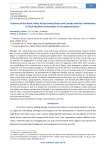
Статья научная
The United States and Canada, along with Russia, Denmark, Iceland, Norway, Finland and Sweden, are the so-called "official" Arctic countries. In the 21st century, The United States and Canada have begun to implement national Arctic strategies and updated them. The accepted documents have both similarities and differences. The United States and Canada are active members of the Arctic Council and view it as a platform for negotiations on a wide range of issues related to the development of the Arctic. The United States has come a long way in the Arctic, including in terms of regulation. Unlike other Arctic countries, the United States has a minimal area of access to the Arctic Ocean, their strategy as a whole is turned “outward”. The first Canadian strategy for the development of the Northern Territories (2013) is addressed directly to the development of the northern periphery of the country, formulates tasks for its sustainable socio-economic development, the development of indigenous peoples, and the support of sovereignty. In 2019, the updated strategy presented already combined national and international goals for the development of the Arctic and the North. To advance national interests in the Arctic, the US and Canada have developed and funded a geographically, infrastructure, stakeholder, and thematically differentiated Arctic research policy in which higher education institutions play an important role and are used to reinforce their geopolitical aspirations. The purpose of the article is to characterize the features of the Arctic strategies of the USA and Canada, as well as to analyze the contribution of universities and colleges in Alaska (USA) and the northern territories and provinces of Canada to the implementation of research policy in the Far North and the Arctic. The practical significance of the paper is in the possibility of its use in the educational process, as well as for the analysis and updating of international aspects of research activities by universities in the Arctic zone of Russia.
Бесплатно
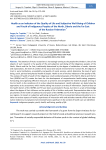
Статья научная
The attention of Arctic researchers is increasingly turning to the people who inhabit it. One of the objects of such research is the quality of life and subjective well-being of the indigenous peoples of the North, Siberia and the Far East, traditionally determined by the degree of satisfaction of needs, interests and expectations, the level of comfort of the social and natural environment for human life, the degree of trust in social institutions, accessibility and quality of social services, which determine the level of well-being, social, spiritual and physical health of people. Health is one of the key indicators of the quality of life. The analysis of health of youth of the indigenous small-numbered peoples of the North, Siberia and the Far East (ISNPNS and FE) creates the basis for the development of comprehensive health-saving programs, forecasting and organizing effective measures to preserve and strengthen the health of people arriving in the Far North in the conditions of its active industrial development. Health indicators are determined by approaches to its assessment, which involve taking into account a variety of information. Empirical data on the health factors of the ISNPNS and FE have been accumulated in Russia, but there is a lack of knowledge about the degree of their influence on the quality of life of children and youth. Representative data on the peculiarities of the health of adolescents and youth of the ISNPNS and FE of the Russian Federation in various regions, its impact on subjective well-being and quality of life are presented. Behavioral patterns in relation to various aspects of health, experiences of interaction with and attitudes towards official and alternative medicine are analyzed; environmental factors significant in the context of health care are identified.
Бесплатно
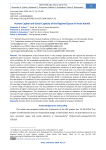
Human Capital and Social Capacity of the Regional Space of Arctic Karelia
Статья научная
The development of the Russian Arctic in the strategic perspective will require the attraction of significant labor resources. However, currently the population outflow trends prevail. The creation of territorial conditions for the expanded reproduction of human capital is of crucial importance in this context. The purpose of the study is to identify the territorial specificity of the conditions for the reproduction of human capital in Arctic Karelia in aspects reflecting the social capacity of the territory. The first task is to study the territorial conditions of human capital reproduction related to its social aspect: health care system, education system, culture, leisure and entertainment. The second task is to assess the possibility of applying the concept of social capacity of space to study the social component of the conditions of human capital reproduction. Complex economic and sociological tools are used. Information bases: Rosstat data, SPARK data, results of the population survey (autumn 2023). A comparative analysis of spatial aspects of the distribution of conditions for the reproduction of human capital and population estimates was carried out. According to the population’s estimates, the most important problems in the health care sector are the shortage of specialists, lack of modern equipment, inaccessibility of complex types of medical care and a narrow range of laboratory tests. The key problems in the field of education are lack of specialists and institutions of higher professional education, decline in the level of education and poor condition of school buildings and kindergartens. The conclusion is made about the structure of indicators of the prospective concept of social capacity of territories and the necessary addition of information bases in accordance with its conceptual logic. The practical significance of the research lies in the formation of analytical bases for ensuring the expanded reproduction of human capital in the territories of the Russian Arctic.
Бесплатно
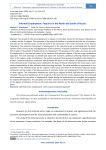
Informal Employment: Features in the North and South of Russia
Статья научная
The spread of informal employment is relevant for the labor market of the Russian Federation as a whole, and for its regions. The relevance of the research problem is associated with the lack of comparative data on the informal sector of the economy of the territories of the north and south of the Russian Federation. The reason for the growth of employment in the informal sector is associated with the development of the service sector and digitalization of the economy, increased competition in regional markets, which leads to the growth of flexible forms of employment. The purpose of the study is to assess the scale of employment in the informal sector in the northern and southern regions of Russia using a production approach. The work attempts to identify and assess the economic conditions affecting informal employment in the regions under consideration. The author examined three groups of conditions and selected indicators characterizing these conditions, which formed the basis for the analysis of employment dynamics in the informal sector. Panel data were collected on the basis of Rosstat information for recent years, maintaining comparability of data collection and processing methods. The study provides an assessment of employment in the informal sector for the regions of the south and north of the Russian Federation draws conclusions on the impact of the above groups of economic factors on employment in the informal sector in these regions. The relationship between per capita gross regional product and informal employment is revealed. The practical significance of the study lies in the fact that the results obtained may be in demand when assessing the processes of employment change during the development of strategies and programs for regional development. The prospects for further research are determined by a more in-depth analysis of the degree of influence of the current socio-economic situation on the level of employment in the regions.
Бесплатно
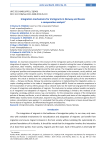
Integration mechanisms for immigrants in Norway and Russia: a comparative analysis
Статья научная
An essential component in the structure of the immigration policy of developed countries is the integration of migrants. The integration policy for migrants is aimed at solving the issues of adaptation, inculturation, labor mobility, naturalization, and political participation. Integration is a reciprocal process which involves the interaction of migrants and the host society. The integration policy goal is the formation of migrants' qualities and competencies that allow them to participate in the economic, social, political, and spiritual spheres of the recipient country. The failure of integration policies inevitably increases the conflict potential of the host society, leads to social exclusion, marginalization of migrants, and an increase in xenophobia. The article is devoted to the comparative analysis of the integration policy of the two Northern states — Norway and Russia. Norway has extensive experience in implementing the integration policy, occupies a leading position in the index of integration of migrants MIPEX. Russia has extensive experience in the incorporation of various ethnic groups into a national state, but the state has long ignored the solution of issues of integration and adaptation of migrants. The study aims to analyze national models and practices of integration and adaptation of migrants. The research methodology is linked to the methods of demography, sociology, political science, law, and statistics. For the comparative analysis of the immigration policies of Norway and Russia, a set of indicators reflecting the quality and status of the integration policy, MIPEX (labor market, family reunification, long-term stay, political participation, protection against discrimination, naturalization) was applied. It is concluded that the policy of integration in Russia should have different objects of regulation, be differentiated by goals and objectives.
Бесплатно

Статья научная
The article examines the problem of intergenerational dynamics of the religiosity level in post-Soviet Russia in the context of cultural transformations, combining the movement towards postsecularity and the domination of secular values of late modern societies. The paper analyzes the all-Russian data, obtained within the framework of the project “World Values Survey”, as well as data on religiosity and value orientations of the population of some Russian Arctic regions, obtained with the direct participation of the author. As a result of the analysis, the author verifies several hypotheses and comes to certain qualitative results. Firstly, there is a generational shift from traditional values to secular-rational values in modern Russia (according to R. Inglehart). The beginning of this process falls on the period of the socialization of the Millennial generation, the context of which is the economic and political reforms of the 1990-2000s. Secondly, the process of the intergenerational transformation of values is organically associated with a decline in the level of religiosity, but it is “delayed” by one generation. The author offers an explanation for this desynchronisation. Thirdly, it is shown that the religiosity level of the population of the Arctic territories is lower (in general and by generations) in comparison with the all-Russian religiosity level. The factors contributing to these differences, according to the author, are the relatively low share of Muslim population in the Russian Arctic and its high level of urbanization.
Бесплатно

International shipping routes for cargo transportation in the Arctic
Статья научная
The main purpose of the article is to study the problems of the functioning and competition of sea routes of cargo transportation in the Arctic region. Methodologically, the work is of a research nature within the framework of the global integrated and northern regional studies, based on interdisciplinarity and complexity. A complex of interdisciplinary tasks is synthesized: to show, against the background of the history of the development of the water area of the northern seas, begun in the era of Velikiy Novgorod, the priority of Russians in the Arctic; the geopolitical and economic significance of the new projects of the Northern Sea Transport Corridor (SMTC), the National Arctic Transport Line (NATL) at the present time; to reveal the presence of many actors in the Arctic region of planet Earth. Operating water area of the Northern Sea Route in 2012-2020 based on legislative acts 1998, 1999, 2012. And while it does not provide a significant share of international transit, it is developing as an internal sea route. The article analyzes the literature of domestic and foreign authors and primary sources, including: Novgorod Chronicles, cartography, current legal acts, Decrees of the President of the Russian Federation, decrees of the Government of the Russian Federation and departmental documents of the Ministry of the Russian Federation for the development of the Far East and the Arctic, FSBI “Administration of the Northern Sea Route”, directorates Northern Sea Route of Rosatom State Corporation, International Monetary Fund (June 24, 2020), China White Book (2018), the Polar Silk Road project, etc. The plurality of sea routes for cargo transportation in the Arctic along the coast of Russia, off the coast of Canada, the Arctic Bridge, the Trans-Arctic sea route, the Polar Silk Road of China; modernization of the NSR infrastructure; implementation of investment projects of the oil and gas and mining complex of global significance generates new challenges and opportunities for the development of the Russian Arctic.
Бесплатно

Internationalization of vocational education in the Arctic council member-states’ universities
Статья научная
Nowadays, the potential for international cooperation in the Arctic is concentrated within the framework of such an influential international structure as the Arctic Council, where Russia is presiding over soon in 2021-2023. The article is devoted to international cooperation evaluation of 15 Arctic universities from 7 Arctic Council member-states with a student contingent of at least 3,600 people (2 in the USA, 1 in Iceland, 5 in Russia, 2 in Finland, 2 in Sweden, 2 in Norway, 1 in Canada). It seems possible to evaluate international cooperation potential between Arctic universities through the prism of 10 quantitative indicators, including the number of international students admitted to the university; number of courses taught in English; number of educational programs for international students; a number of foreign scientists invited to the university, etc. We can evaluate both academic mobility within the Arctic universities and vocational education internationalization due to accumulated statistical data.
Бесплатно

Labor Market Features in the Russian North: Employment, Wages and the Role of Northern Allowances
Статья научная
This article focuses on the labor market in the Russian northern regions. The labor market in the Russian North was formed due to the state policy of the no longer existing state, aimed at the active attraction of migrants from other territories for the industrial development of the country. This policy of attracting migrant labor in the state was implemented mainly through the creation of the institution of wages, which provided additional northern payments to the salary, designed to compensate for the discomfort of living and working conditions in the North. This led to an increase in employment in the North. The research goal is to study the formation and development of the wage institution, as well as to determine the impact of wages on employment in modern conditions. The article presents the history of formation of the institution of wages in the Russian North. The dynamics of labour market indicators is given, the change in the ratio of wages in the North is presented, based on official statistical data over the past 15 years. The results of the study show that the northern territories have problems of the labor market that have arisen in recent decades: high levels of unemployment, reduced employment, and wages, once being a significant factor, had a positive impact on employment, but today contribute to the decline in the economic attractiveness of life in the North.
Бесплатно

